PEUGEOT 5008 2014 Owners Manual
Manufacturer: PEUGEOT, Model Year: 2014, Model line: 5008, Model: PEUGEOT 5008 2014Pages: 404, PDF Size: 23.34 MB
Page 171 of 404

9
Driving169
Emergency braking
In the event of a failure of the main service brake or in an exceptional situation (e.g. driver taken ill, under instruction, etc) a continuous pull on the control lever on the control lever on the control leverA will stop the vehicle . The dynamic stability control (DSC) provides stability during emergency braking. If there is a fault with the emergency braking,
one of the following messages will be displayed: - "Parking brake faulty". - "Parking brake control faulty".
If a failure of the DSC system is signalled by the illumination of this warning lamp, then braking stability is not guaranteed. In this event, stability must be assured by the driver by repeating alternate "pull release" actions on control lever A .
Before leaving the vehicle, check that parking brake warning lamp in the instrument panel is on, not flashing.
The emergency braking must only be used in exceptional circumstances.
Particular situations
In certain situations (e.g. starting the engine), the parking brake can automatically alter its force. This is normal operation. To advance your vehicle a few centimetres without starting the engine, but with the ignition on, press on the brake pedal and release the parking brake by pulling then releasing control lever A . The full release of the parking brake is confirmed by the warning lamp in the control lever A and the warning
lamp in the instrument panel going off and the display of the message "Handbrake off ". If a parking brake fault occurs while applied or if the battery runs flat, an emergency release is always possible.
Page 172 of 404
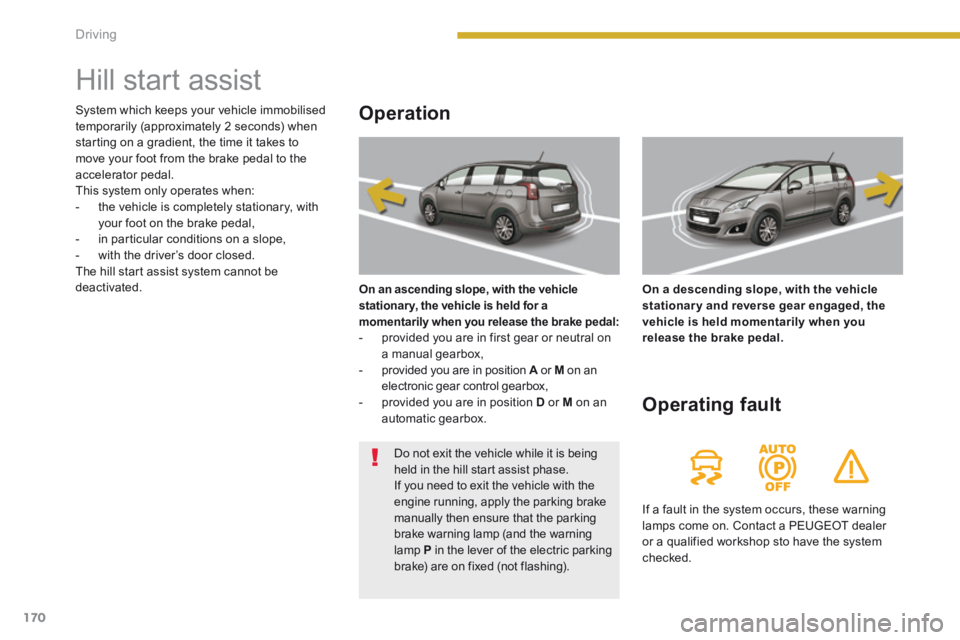
Driving
170
Hill start assist
Operation
On an ascending slope, with the vehicle stationar y, the vehicle is held for a momentarily when you release the brake pedal: - provided you are in first gear or neutral on a manual gearbox, - provided you are in position A or A or AM on an electronic gear control gearbox, - provided you are in position D or M on an automatic gearbox.
On a descending slope, with the vehicle stationary and reverse gear engaged, the vehicle is held momentarily when you release the brake pedal.
Operating fault
If a fault in the system occurs, these warning lamps come on. Contact a PEUGEOT dealer or a qualified workshop sto have the system checked.
System which keeps your vehicle immobilised temporarily (approximately 2 seconds) when starting on a gradient, the time it takes to move your foot from the brake pedal to the accelerator pedal. This system only operates when: - the vehicle is completely stationary, with your foot on the brake pedal, - in particular conditions on a slope, - with the driver’s door closed. The hill start assist system cannot be deactivated.
Do not exit the vehicle while it is being held in the hill start assist phase. If you need to exit the vehicle with the engine running, apply the parking brake manually then ensure that the parking brake warning lamp (and the warning lamp P in the lever of the electric parking brake) are on fixed (not flashing).
Page 173 of 404
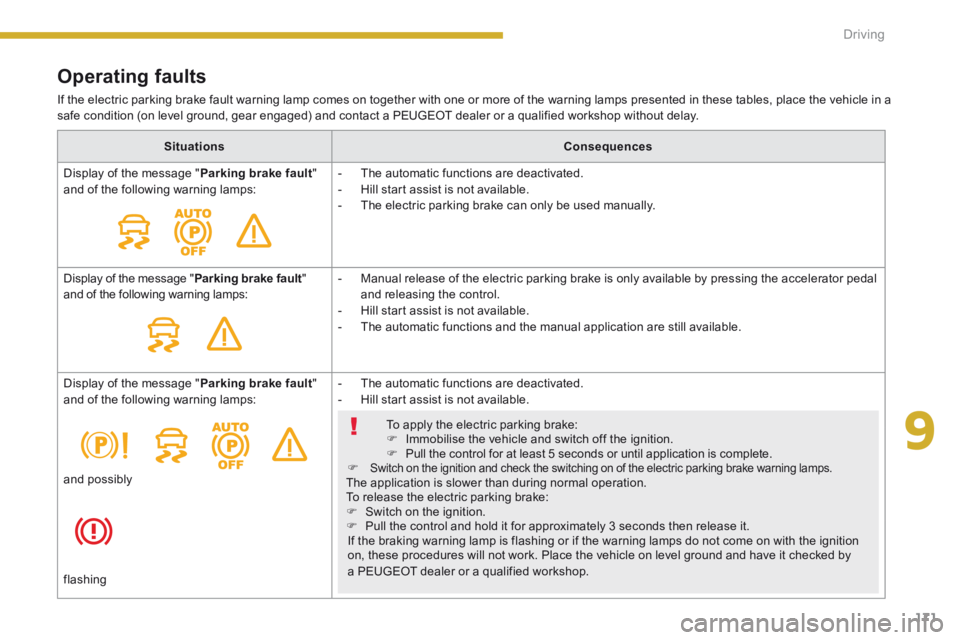
9
Driving171
Operating faults
If the electric parking brake fault warning lamp comes on together with one or more of the warning lamps presented in these tables, place the vehicle in a safe condition (on level ground, gear engaged) and contact a PEUGEOT dealer or a qualified workshop without delay.
SituationsConsequences
Display of the message " Parking brake fault " and of the following warning lamps: - The automatic functions are deactivated. - Hill start assist is not available. - The electric parking brake can only be used manually.
Display of the message " Parking brake fault " and of the following warning lamps: - Manual release of the electric parking brake is only available by pressing the accelerator pedal and releasing the control. - Hill start assist is not available. - The automatic functions and the manual application are still available.
Display of the message " Parking brake fault " and of the following warning lamps: - The automatic functions are deactivated. - Hill start assist is not available.
To apply the electric parking brake: Immobilise the vehicle and switch off the ignition. Pull the control for at least 5 seconds or until application is complete. Switch on the ignition and check the switching on of the electric parking brake warning lamps. The application is slower than during normal operation. To release the electric parking brake: Switch on the ignition. Pull the control and hold it for approximately 3 seconds then release it. If the braking warning lamp is flashing or if the warning lamps do not come on with the ignition on, these procedures will not work. Place the vehicle on level ground and have it checked by a PEUGEOT dealer or a qualified workshop.
and possibly
flashing
Page 174 of 404
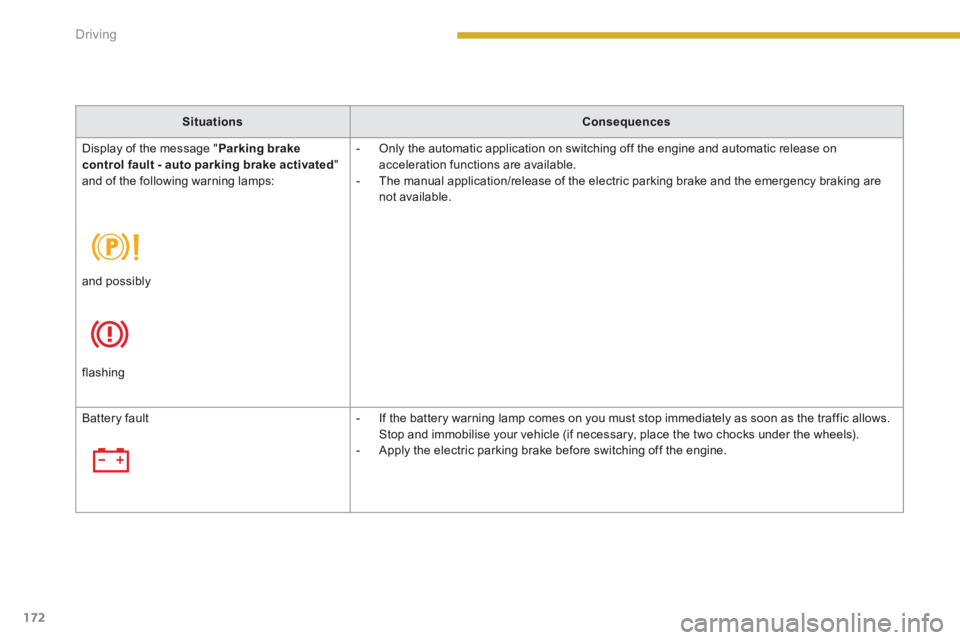
Driving
172
SituationsConsequences
Display of the message " Parking brake control fault - auto parking brake activated " and of the following warning lamps:
- Only the automatic application on switching off the engine and automatic release on acceleration functions are available. - The manual application/release of the electric parking brake and the emergency braking are not available.
and possibly
flashing
Battery fault - If the battery warning lamp comes on you must stop immediately as soon as the traffic allows. Stop and immobilise your vehicle (if necessary, place the two chocks under the wheels). - Apply the electric parking brake before switching off the engine.
Page 175 of 404

9
Driving173
System which projects various information onto a transparent strip in the field of vision of the driver so that they do not have to take their eyes off the road. This system operates when the engine is running and the settings are stored when the ignition is switched off.
Head-up display
1. Head-up display on/off. 2. Brightness adjustment. 3. Display height adjustment. The strip is activated by pressing one of the buttons.
Once the system has been activated, the following information is grouped together in the head-up display: A. The speed of your vehicle. B. Cruise control/speed limiter information.
Buttons Displays during operation
C. "Distance alert" information (depending on ve r s i o n).
Page 176 of 404
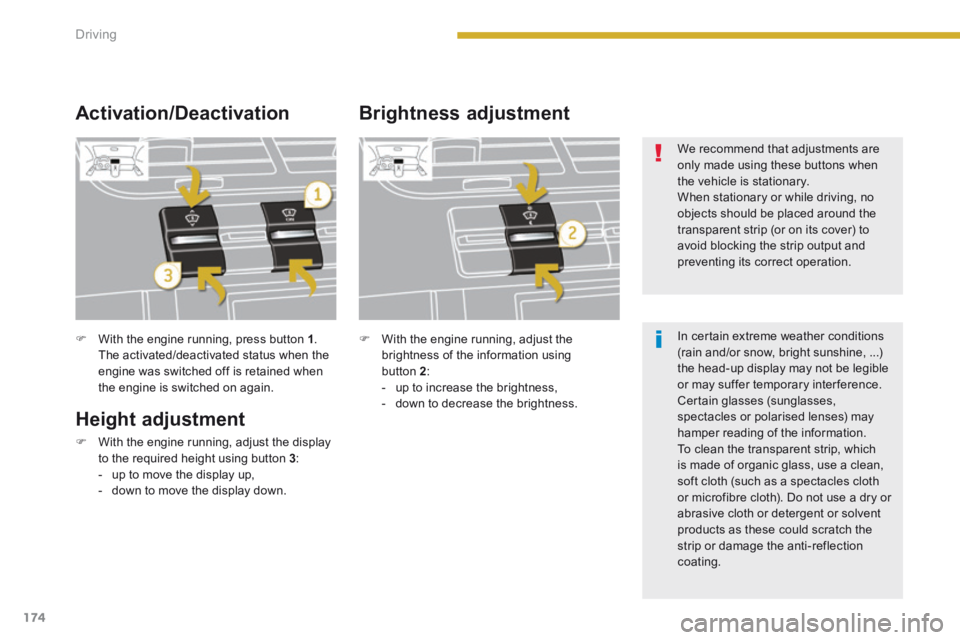
Driving
174
With the engine running, press button 1 . The activated/deactivated status when the engine was switched off is retained when the engine is switched on again.
Height adjustment
With the engine running, adjust the display to the required height using button 3 : - up to move the display up, - down to move the display down.
Activation/Deactivation Brightness adjustment
With the engine running, adjust the brightness of the information using button 2 : - up to increase the brightness, - down to decrease the brightness.
We recommend that adjustments are only made using these buttons when the vehicle is stationary. When stationary or while driving, no objects should be placed around the
transparent strip (or on its cover) to avoid blocking the strip output and preventing its correct operation.
In certain extreme weather conditions (rain and/or snow, bright sunshine, ...) the head-up display may not be legible or may suffer temporary interference. Certain glasses (sunglasses, spectacles or polarised lenses) may
hamper reading of the information. To clean the transparent strip, which is made of organic glass, use a clean, soft cloth (such as a spectacles cloth or microfibre cloth). Do not use a dry or abrasive cloth or detergent or solvent products as these could scratch the strip or damage the anti-reflection coating.
Page 177 of 404
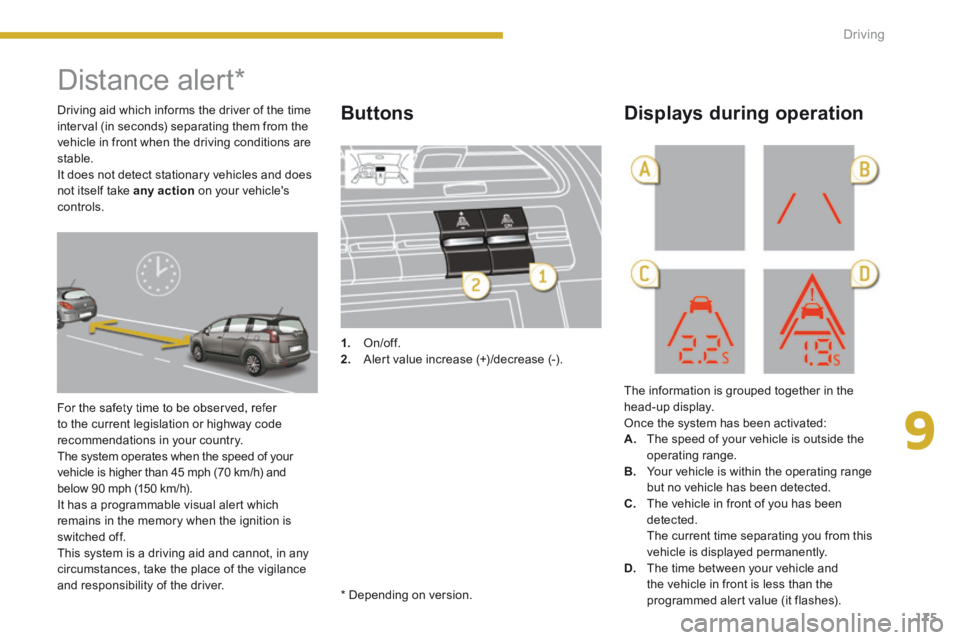
9
Driving175
Distance alert *
For the safety time to be observed, refer to the current legislation or highway code recommendations in your country. The system operates when the speed of your vehicle is higher than 45 mph (70 km/h) and below 90 mph (150 km/h). It has a programmable visual alert which remains in the memory when the ignition is
switched off. This system is a driving aid and cannot, in any circumstances, take the place of the vigilance and responsibility of the driver.
1. On/off. 2. Alert value increase (+)/decrease (-).
The information is grouped together in the head-up display. Once the system has been activated:
A. The speed of your vehicle is outside the operating range. B. Your vehicle is within the operating range but no vehicle has been detected. C. The vehicle in front of you has been detected. The current time separating you from this vehicle is displayed permanently. D. The time between your vehicle and the vehicle in front is less than the programmed alert value (it flashes).
Buttons Displays during operation Driving aid which informs the driver of the time interval (in seconds) separating them from the vehicle in front when the driving conditions are stable. It does not detect stationary vehicles and does not itself take any action on your vehicle's controls.
* Depending on version.
Page 178 of 404
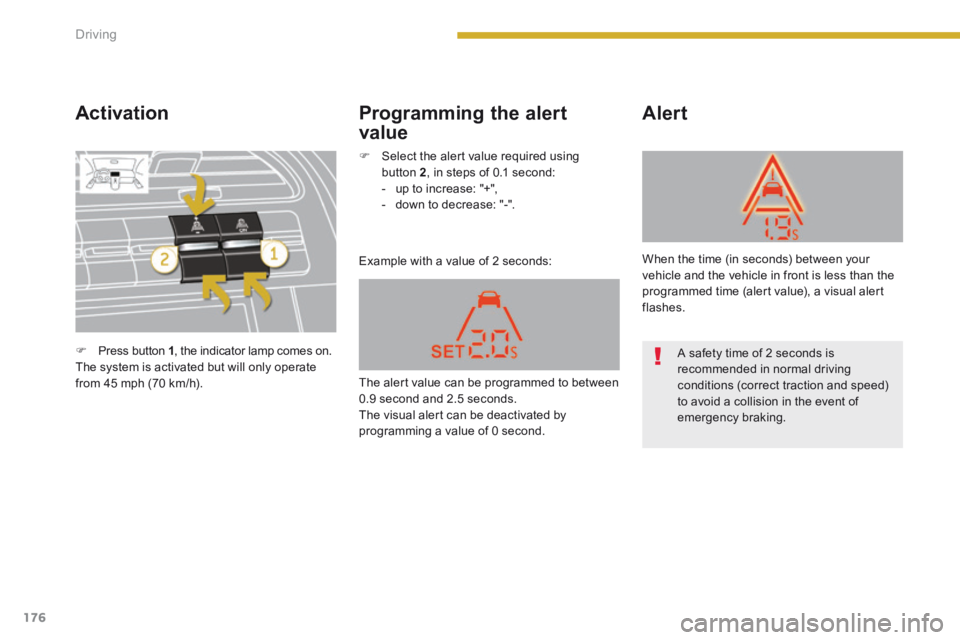
Driving
176
Activation
Example with a value of 2 seconds:
Alert Programming the alert
value
Press button 1 , the indicator lamp comes on. The system is activated but will only operate from 45 mph (70 km/h). The alert value can be programmed to between 0.9 second and 2.5 seconds. The visual alert can be deactivated by programming a value of 0 second.
When the time (in seconds) between your vehicle and the vehicle in front is less than the programmed time (alert value), a visual alert flashes.
A safety time of 2 seconds is recommended in normal driving conditions (correct traction and speed) to avoid a collision in the event of emergency braking.
Select the alert value required using button 2 , in steps of 0.1 second: - up to increase: "+", - down to decrease: "-".
Page 179 of 404

9
Driving177
Deactivation
Reactivation
Press button 1 again to reactivate the system. The last value programmed is retained and the indicator lamp comes on.
Operating limits
The system switches to standby automatically if the sensor does not detect the vehicle in front correctly (very difficult weather conditions, sensor out of adjustment, ...). A message is displayed in the multifunction screen. The vehicle being followed may not be detected in certain conditions such as, for example: - when turning, - when changing lane, - when the vehicle in front is either too far ahead (maximum range of the sensor: 100 m) or stationary (in a traffic jam, ...), When the vehicle being followed is much too near (time between the two vehicles less than 0.5 seconds), the display remains fixed at 0.5 seconds.
If the indicator lamp in button 1flashes, have the system checked by a PEUGEOT dealer or a qualified workshop. This system is not an anti-collision radar and it does not act of the movement of your vehicle. It provides information but cannot, in any circumstances, take the place of the vigilance and responsibility of the driver.
Press button 1 to deactivate the system, the indicator lamp goes off.
Page 180 of 404
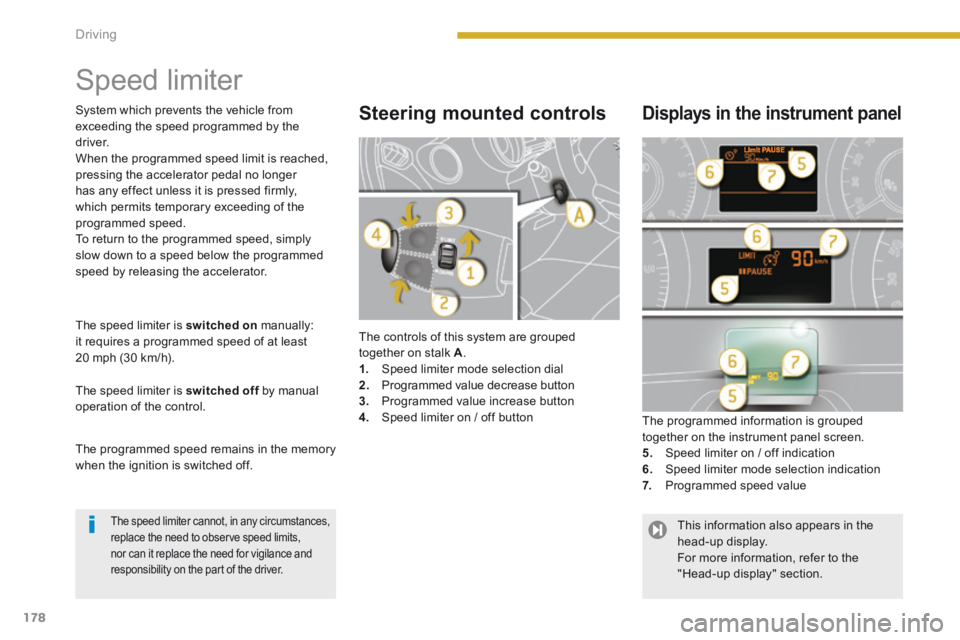
Driving
178
Speed limiter
The controls of this system are grouped together on stalk A . 1. Speed limiter mode selection dial 2. Programmed value decrease button 3. Programmed value increase button 4. Speed limiter on / off button The programmed information is grouped together on the instrument panel screen. 5. Speed limiter on / off indication 6. Speed limiter mode selection indication 7. Programmed speed value
Steering mounted controls Displays in the instrument panel
The speed limiter is switched on manually: it requires a programmed speed of at least 20 mph (30 km/h).
The speed limiter is switched off by manual switched off by manual switched offoperation of the control.
The programmed speed remains in the memory when the ignition is switched off.
System which prevents the vehicle from exceeding the speed programmed by the driver. When the programmed speed limit is reached, pressing the accelerator pedal no longer has any effect unless it is pressed firmly, which permits temporary exceeding of the programmed speed. To return to the programmed speed, simply slow down to a speed below the programmed speed by releasing the accelerator.
The speed limiter cannot, in any circumstances, replace the need to observe speed limits, nor can it replace the need for vigilance and responsibility on the part of the driver.
This information also appears in the
head-up display. For more information, refer to the "Head-up display" section.